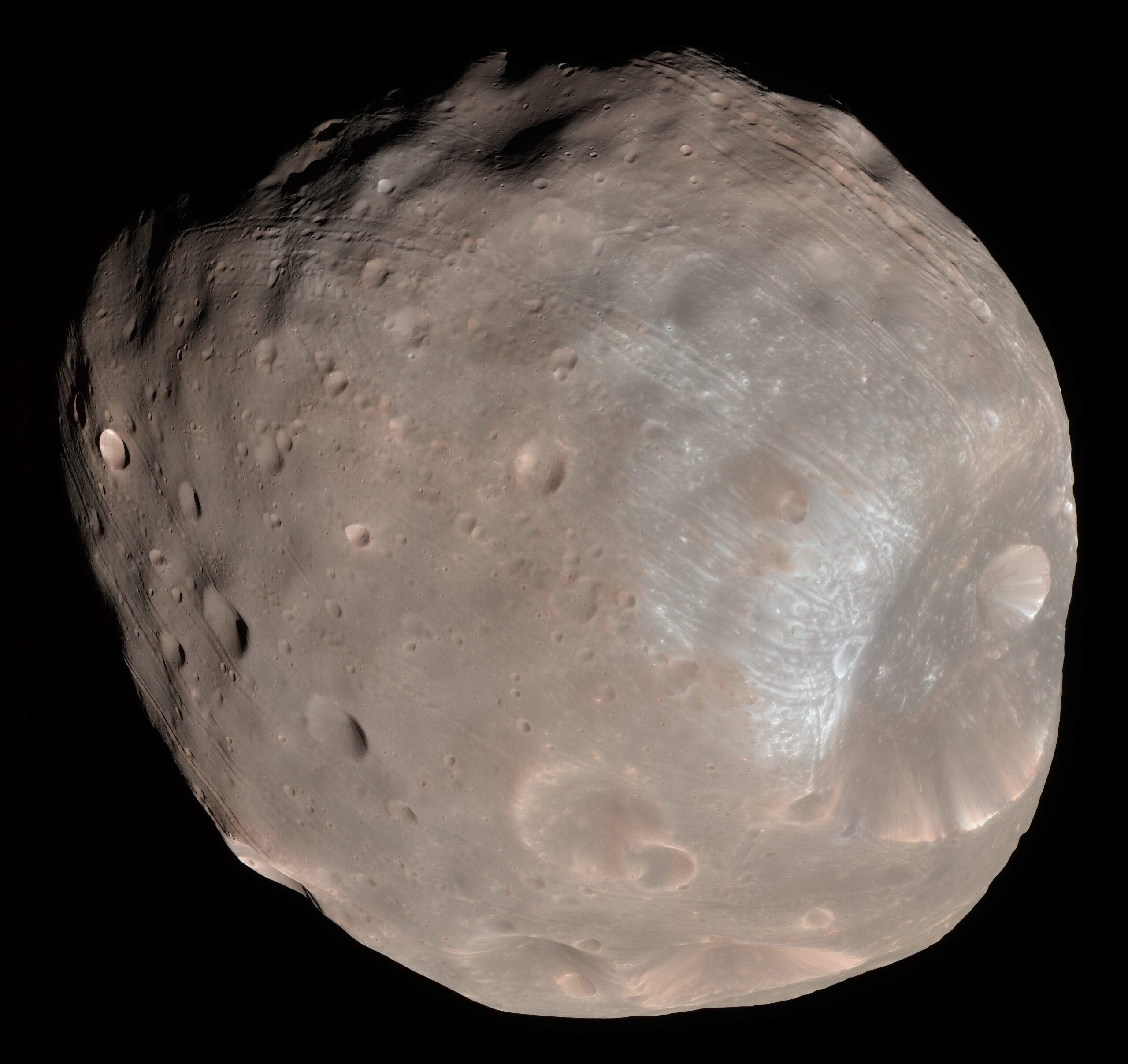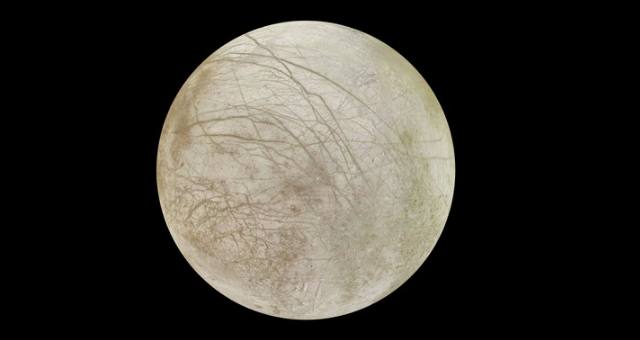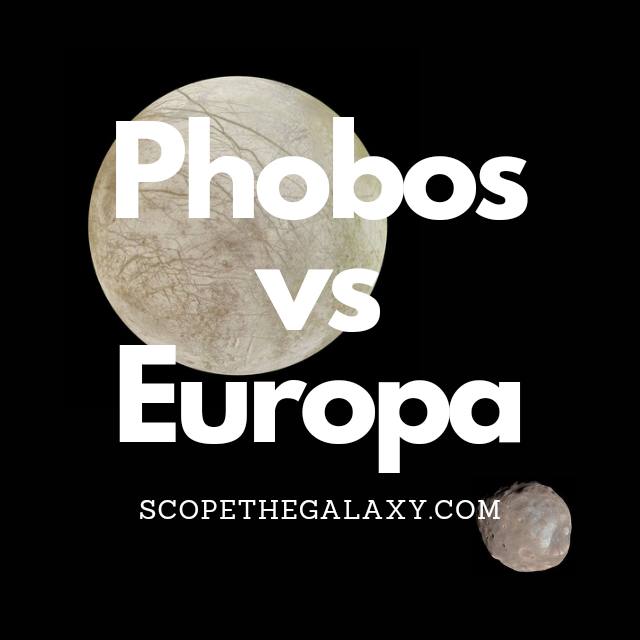*This post may contain affiliate links. This means we may make a commission if you purchase an item using one of our links*
The main differences between Phobos and Europa are that Phobos is far smaller with a diameter of 22.53km while Europa’s diameter is 3,121.6km, Europa orbits Jupiter while Phobos orbits Mars and Europa may have an icy ocean underneath its surface while Phobos does not.
There are various other differences between the two so, continue reading for a more detailed look at each body along with their similarities and differences below.
What Is The Moon Phobos?
Table of Contents

Phobos is the larger and innermost of the Martian moons, named after the Greek God of fear and panic. This rocky satellite measures approximately 27 x 22 x 18 kilometers and possesses an irregular shape.
Flying only 270 km above Mars’s surface, Phobos orbits the Martian surface so closely that it spins around the planet three times a day (each orbit takes 7 hours and 39 minutes). And this proximity means that the moon cannot always be seen from Mars’ surface (it all depends on where you’re standing).
In general, Phobos rises in the west, passes through the sky in around 4 hours, and sets in the east. And this process occurs twice during one Martian day.
Phobos travels 1.8 m closer to Mars every 100 years, which means this doomed moon will one day crash into its planet or break up into rings. Still, this won’t happen for another 50 million years or so.
The moon is covered in streak patterns from impact craters, the most significant of which is the crater Stickney, with a diameter of 9.7 km. Phobos has weathered thousands of meteorite impacts, one of which almost shattered it to pieces.
It was first discovered by the American astronomer Asaph Hall on 17th August 1877. But, it can be difficult for astronomers to see as it is one of the least reflective bodies in the solar system with an albedo of 0.071.
Despite its small stature, Phobos experiences wildly varying temperatures on its dark side compared to the light side. Measurements on the light side of the moon suggest that temperatures can rise to -4 degrees Celsius, a sort of brisk winter’s day that would be cold but tolerable.
In contrast, temperatures on the dark side can drop to -112 degrees Celsius, even though the two areas are just a few kilometers apart. The probable cause is fine surface dust that cannot retain heat, allowing temperatures to drop rapidly.
The low density of Phobos suggests its composition is similar to carbonaceous chondrite meteorites, which could mean that Phobos is a captured asteroid.
What Is The Moon Europa?

Europa is the smallest of the Galilean moons, first discovered on 8th January 1610. The surface of this icy world is frozen, but scientists believe a watery ocean could lie beneath the surface. And in 2012, researchers found a possible water plume in the Southern polar region of Europa.
This research is yet to be confirmed; still, it gives us reasonable grounds to hypothesize that water could exist on this icy moon.
Estimates place Europa at around 4.5 billion years old (the same age as its planet, Jupiter), and its average distance from the Sun is approximately 780 million km.
It has a diameter of 3,121.6km, which makes it larger than Pluto but smaller than the Earth’s moon, and the maximum temperature is a chilly -160 degrees Celsius. In regards to mass, it measures in around 4.8 × 10^22 kg.
Europa takes three-and-a-half days to orbit its planet at an average distance of 670,900km, and it is tidally locked, meaning the same side of the moon always faces Jupiter.
Among the fascinating features of this ice moon is its incredibly reflective nature. The icy crust of this body provides a light reflectivity of 0.64 – the highest of any moon in the solar system.
Data from the Galileo spacecraft suggests that Europa is composed of an iron core, rocky mantle, and silicate rock (a similar composition to Earth).
The moon’s surface is covered in cracks, which many theorize could result from tidal currents beneath the surface. It is this potential of water – and of life – that keeps astronomers so interested in this moon.
Europa might be small, but astronomers estimate it holds two to three times more water than the Earth. In addition, this moon possesses the essential elements for life, such as carbon, oxygen, hydrogen, and nitrogen.
There may be no solar energy on this moon, but hydrothermal vents could provide energy, and tidal heating from Jupiter could provide a heat source and keep the moon stable enough for life to form. In addition, the liquid ocean is well protected from radiation from thick, icy surfaces.
Similarities Between Phobos And Europa
As both are natural satellites, Phobos and Europa do share a few similarities, which includes the following:
- Both have a rocky, terrestrial surface.
- Neither have rings surrounding them.
- Both are tidally locked to their planet.
- Both orbit their planet in an elliptical pattern.
- Neither have tectonic plates.
- Neither have a magnetic field.
- Europa and Phobos have a practically non-existent axial tilt.
Differences Between Phobos And Europa
As for the differences between the two so, they include the below:
- Phobos orbits Mars whilst Europa orbits Jupiter .
- Europa is a spherical shape while Phobos is not.
- Europa has a diameter of 3,121.6km whilst Phobos has a diameter of 22.53km.
- Phobos has no atmosphere whilst Europa has a very thin atmosphere composed of oxygen.
- A day on Phobos takes 7 hours 39 minutes whilst a Europa day 3.5 days.
- It takes Phobos 7 hours 39 minutes to orbit Mars and around the Sun in 687 days whilst Europa orbits Jupiter in in 3.5 days and the Sun in 12 years.
- Phobos’ temperature ranges between -4 to -112 degrees Celsius whilst Europa’s is between -160 degree Celsius.
- Europa orbits Jupiter at an average distance of 442,200km whilst Phobos is 6,000km away from Mars.
- Europa’s density is 3.01 g/cm³ whilst Phobo’s density is 1.88 g/cm³.
- Europa is amongst the brightest moons in our solar system while Phobos is not.
- Europa’s mass is 4.8 × 10^22 kg whilst Phobos’ mass is 10.6 × 10^15 kg.
- Phobos’ gravitational strength is 0.0057 m/s² whilst Europa’s is 1.428 m/s².
- Phobos only orbits Mars 6,000km away and is getting closer to the planet by 1.8 meters every 100 years.
- Europa may have an icy ocean underneath its surface.
Summary
Both Europa and Phobos share a few features such as their terrestrial composition, neither have tectonic activity and are tidally locked to their respective planets but, they are still very different from one another.
Whether it be in regards to mass, size, density, the length of their days, temperatures and more, Europa and Phobos are distinct enough in their own rights to be looked as independent entities as opposed to just another moon orbiting a planet.

